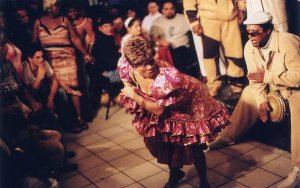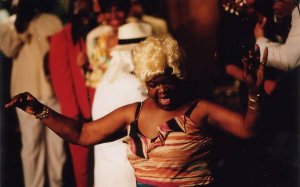
Surviving on the dance floor
 Many Cuban exiles live in New York City and the nearby Latino neighborhoods in New Jersey.
Some of them are the central characters in "Dame la mano".
Many Cuban exiles live in New York City and the nearby Latino neighborhoods in New Jersey.
Some of them are the central characters in "Dame la mano".
Rumba as a necessity

For Cubans dancing is one of life's necessities, like walking, eating, making love and breathing. This inner drive creates a strong zest for life. Dancing means much more than just 'a night out' --for the characters in this film it's their oxygen. It's amazing how full of vitality they are and how music and dance helps them forget their day-to-day worries and even seems to ward off fate. Besides their heart, there's something else beating: the clave, the ancient rhythm that shapes all Afro-Cuban music. Living in exile, our characters' need for rumba is even stronger. Some are laborers, others are musicians and dancers and each of them has a close connection to La Esquina Habanera. Many of them have been forced to leave one or more relatives behind in Cuba. Some talk about this in a matter-of-fact way, as if they are resigned to their fate, while others openly express their grief or melancholy.
Give me your hand
During the film you will get to know them and experience a vibrant rumba night at La Esquina. People of all ages and from all social backgrounds present an extraordinary sight: gold necklaces, shiny dancing shoes, wigs, mini-skirts, white hats, sunglasses, oversized sweaters, winter hats and low-cut dresses. There are dancers, musicians and regular visitors: Rafaela, a voluptuous 62-year-old, who works long hours in a large kitchen and prefers dancing to eating; Tony, the club owner who made his dream come true by creating a place for the rumba in New Jersey; Leonardo, a mechanic who puts in over 150 hours of overtime each month and always listens to music to dispel his melancholy; David, the musical director of the house orchestra who still remembers the 'prison rumbas' from his time behind bars -- because he refused to go the war in Angola; Pedro, a skilled dancer who had to scrape together a living by working as a gigolo when he'd just arrived in the States; Karim, the choreographer and dancer who's been 'misleading' her greatest enemy -- cancer -- by dancing for seven years now. These people cherish the song "Dame la mano" -- that's sung in La Esquina: "Give me your hand, give me your hand dear bosom friend, I sway, I can't stand..." It's music and dance that keep these people on their feet.
- Director: Heddy Honigmann
- Research: Heddy Honigmann & Karim Noack
- Script: Heddy Honigmann & Ester Gould
- Photography: Gregor Meerman
- Sound: Piotr van Dijk
- Editor: Mario Steenbergen
- Sound designer: Hugo Dijkstal
- Producer: Pieter van Huystee
- Production managers New York: Flavia Fontes, Tânia Cypriano
- A production by: VPRO Television & Pieter van Huystee Films in co-operation with Appel&Honigmann
- Running time: 120 minutes
- Première: September 2003, Museum of Modern Art, New York (during retrospective)
- Theatrical distribution: A-film
- International sales: Idéale Audience International